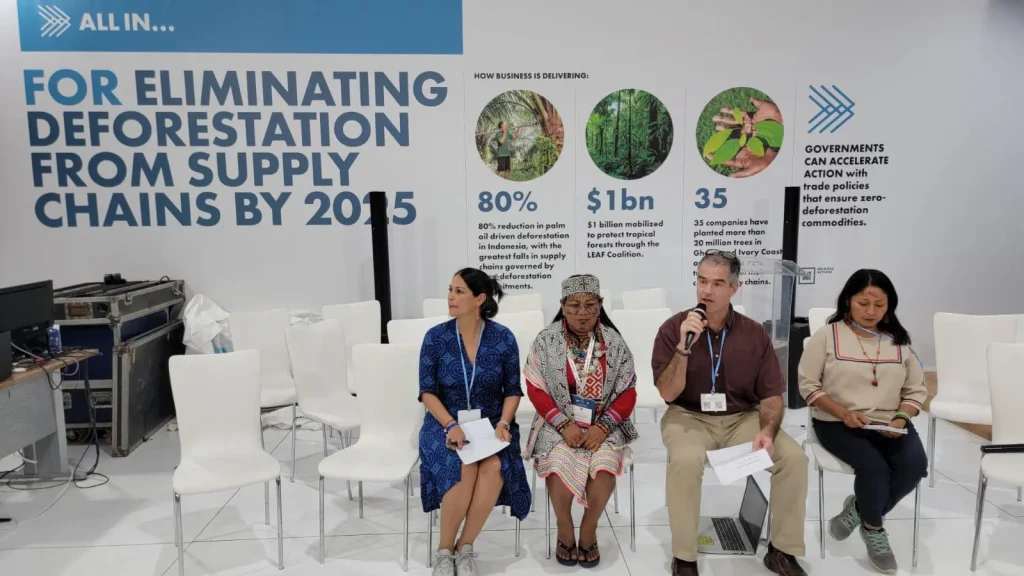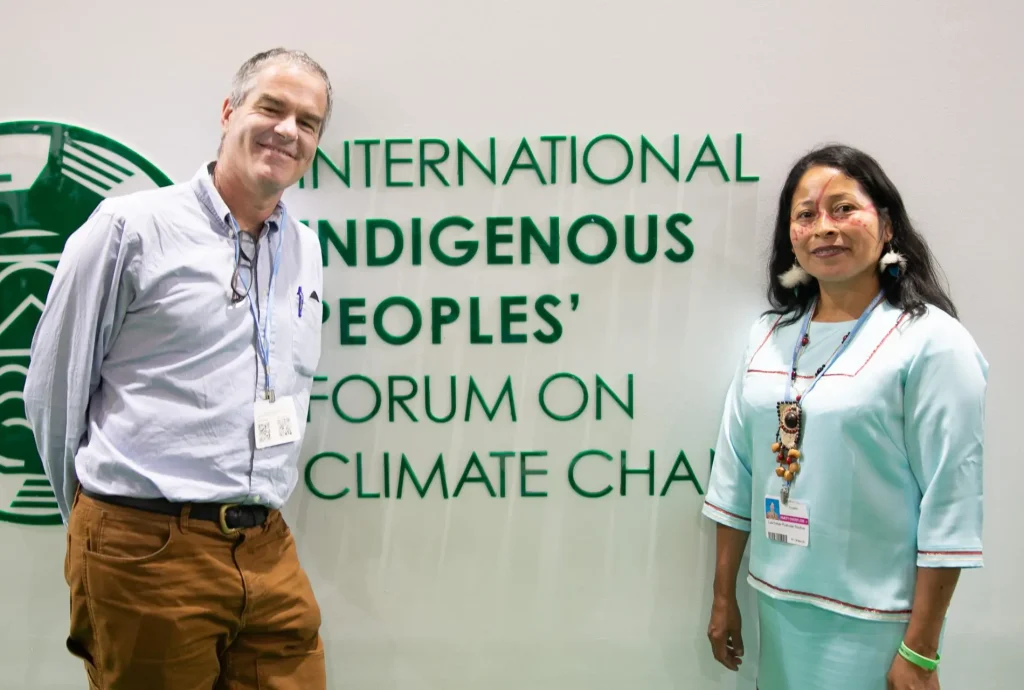Indigenous Leadership in Climate Action: Nature and Culture at COP27
11/16/2022
Nature and Culture attends COP27, the U.N. climate conference held in Sharm El Sheikh, Egypt, November 6 – 18, 2022.
The opportunity for Nature and Culture to attend COP, participate in the climate conversation and amplify Indigenous voices in climate action is a significant milestone for the organization.
Nature and Culture’s President & CEO, Matt Clark and Lolita Piyahuaje, Vice President of the Confederation of Indigenous Nationalities of the Ecuadorian Amazon’s (CONFENIAE) attended the conference, speaking together on a panel about Indigenous leadership within Pastaza Province’s jurisdictional REDD+ program. This program is the first of its kind in Ecuador, bringing together 7 Indigenous nationalities, the local provincial government, CONFENIAE, and Nature and Culture International to implement activities to reduce deforestation.

The project provides a new set of insights into the processes and structures that allow for meaningful Indigenous participation, equitable benefit sharing, and free and prior consent, all major themes of this year’s conference.
Watch the full presentation below.
COP27 Presentation: Indigenous Leadership in Amazonian REDD+ Program
COP27 Major Themes Related to our work
Providing carbon funding directly to Indigenous Peoples
The U.N.’s Intergovernmental Panel on Climate Change (IPCC) said earlier this year that Indigenous Peoples are “critical” to addressing climate change. Their report cited the fundamental importance of recognizing their land tenure, knowledge systems, and management of forests.
Reducing tropical deforestation can contribute as much as 20 percent of the solution to reach the U.N. Paris Accord target of halting the average global temperature to 1.5° Celsius above pre-industrial levels. Indigenous Peoples live on about 60 percent of the world’s tropical forests. And they are not receiving fair compensation for the sustainable management of these forests. Of the 1.7 billion that was pledged at COP26 to support Indigenous Peoples and local communities’ forest tenure, only about 7 percent, of the 19 percent already delivered, has gone directly to Indigenous-led organizations.
Although a theme from years prior, the slow pace of carbon funding reaching Indigenous nationalities received particular attention at this year’s climate meeting. Lolita addressed the issue in her remarks as did numerous Indigenous speakers on other panels and workshops. Among potential solutions, they highlighted the need for two-way knowledge exchange between Indigenous and non-Indigenous actors and a joint commitment to create funding and administrative structures consistent with Indigenous forms of governance. They also stressed the importance of building the technical, administrative and financial capacity of all actors in order to facilitate direct funding to Indigenous Peoples.
On the complex nature of providing timely carbon funding directly to Indigenous Peoples Matt Clark explains, “On one hand, there’s this urgency to combat climate change. We’re rapidly blasting past the Paris Climate Accord. That goal will soon be unattainable if we don’t take drastic actions now. There’s also clearly an urgency that Indigenous Peoples feel to be compensated for conserving their forests. They’re tired of waiting. On the other hand, it’s critical to take the time to build trust and mutual understanding. Carbon markets are technically, socially, and politically COMPLICATED and the free, prior, and informed consent that Indigenous Peoples demand and deserve cannot be completed quickly.”

Pastaza: a case study for Indigenous Inclusion in climate mitigation.
Nature and Culture has long-established relationships with Indigenous communities that are crucial to ensuring transparency and mutual benefit. Though a work in progress, the multi-stakeholder REDD+ Pastaza project is a good example of this.
The partnership Nature and Culture established with the provincial government of Pastaza, 7 Indigenous nationalities, and the Indigenous Confederation, CONFENIAE has led to a shared framework where all parties have endorsed guiding principles that recognize Indigenous rights.
The collaborative framework also utilizes a trust fund that accepts and channels funds to Indigenous and non-Indigenous actors alike with control and oversight from a board of directors that includes representatives of the 7 Indigenous nationalities, the Indigenous confederation, and the provincial and other local governments.
These funds are used to implement four actionable activities: restoration, conservation, sustainable livelihoods, and improvements to governance mechanisms. Throughout this process, local Indigenous communities are consulted and their Planes de Vida, or community development and territorial zoning plans according to an Indigenous worldview are incorporated into the project design.
These Planes de Vida are overseen by Indigenous representatives who understand the Indigenous worldview and can encourage further community participation.
It is important to empower women and youth. Revenues from this project may also support gender equality training, as well as improve healthcare, housing, education, better living conditions, and clean water.
Chakras, or multi-species traditional gardens, are another way funds are used which provide food security and a means for additional income. Medicinal, and/or culturally important crops can be harvested and brought to market. Furthermore, there is an interest in developing a bigger market for forest products. Products would use a ‘green seal’ that signals they are sustainably sourced from the tropical rainforests.
To have a real climate impact, Indigenous Peoples must be consulted, considered, and invited to participate as equal partners. This project in Pastaza is beginning to show that not only is that possible, but it also has direct and lasting conservation impacts.


